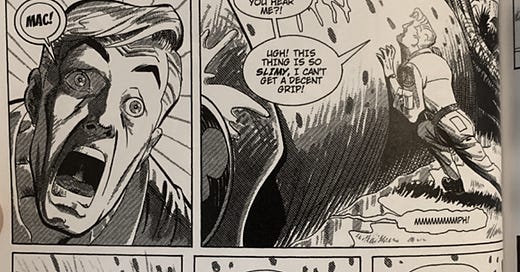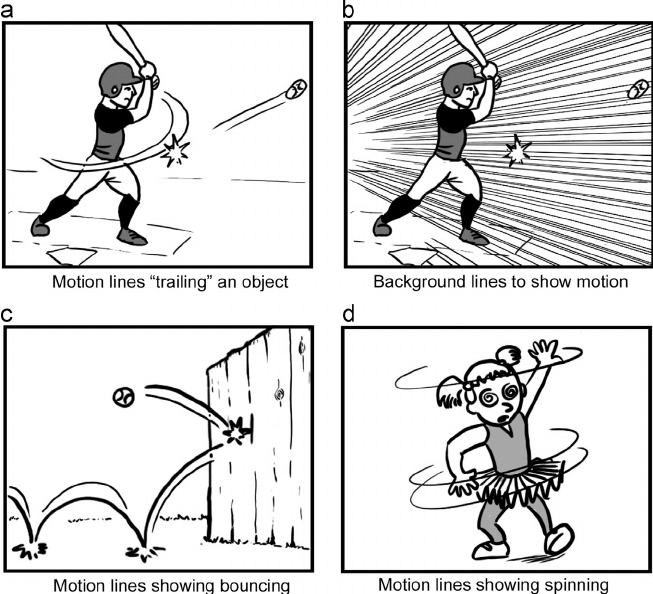Over the past year I’ve taught some courses to groups of 4-7-year-olds at the Mountaineer Homeschool Hub. See my posts on teaching American Folk Tales, Kidfit, and Making Stories.
One conclusion from the post on making stories was that I was aiming too high for my age range. Trying to sustain some sort of ongoing project across classes didn’t work well. And when it came to illustrating their stories, the most serious artists in the class would spend all class on a single scene and the story wouldn’t progress.
I decided something more visual was in order, as well as a format that encouraged them to show a sequence of events on a single page. Thus my next class was “Comics for Kids.” Compared to the storybook class, I had humbler aims but greater success.
I started by emailing comic writer Chuck Dixon for advice via his “Ask Chuck Dixon” podcast. Part of his answer was to give the kids lots of examples. So I started most classes by handing around pages from different comics. I tried to find examples that showed the comics medium could be more than just the superhero genre. So I gave them examples from Carl Barks’s Donald Duck and Scrooge McDuck comics, Geronimo Stilton graphic novels, Graham Nolan’s Monster Island, and comic strips like Nancy and Calvin and Hobbes.
At first, I tried to pair the examples with a little bit of comic history — “this is how Carl Barks developed a fandom even when his name wasn’t on his books” — but that didn’t hold their attention, so I let it drop. Maybe when they’re older….
I picked examples with an eye on illustrating whatever technique I wanted them to work on that day. And the trick that worked for me was focusing on one technique a day, going over examples with them, then having them try it on their own.
We often started class with the “and what happened next?” storytelling game I did in the storybooks class. They like that, even if some are shy about taking their turn. It helps if I play up the wackiness of their different plot developments and occasionally act them out. Aside from getting them more comfortable talking and interacting with one another, the game also helps reinforce the idea that stories need a character with goals, some sort of problem, and an ending.
After the group story I handed around the example comics and went over them with the kids, trying to draw their attention to this technique or that.
Then I would draw illustrations of that technique on the chalkboard. (We have our classes in an old elementary school, so I had a full board to work on. You could use a smaller chalkboard or whiteboard or drawing pad at home.)
For instance, the first class was on drawing facial expressions. On the board I drew a cartoon man, complete except for blanks where the eyes, eyebrows, and mouth should be. I asked the kids to think about what an angry face looks like, and had volunteers come up one at a time to do their own rendition by adding angry eyes and angry mouth to the drawing. Then we went through the same exercise with scared, sad, happy, and so forth.
As we went along the kids started suggesting their own expressions — “I can do someone who’s dizzy!”; “I can do someone who’s freezing!” — and I let them do those as well.
After that, I drew three equal sized panels on the board and reminded them of how every story should have a beginning, middle, and end. Then I said we can show a story just by showing changes in what the character is feeling.
In each panel I drew the outline of a cat. In the first panel I drew an angry face on the cat, in the second a surprised face, and in the third a happy face.
“What is the cat angry about in this first panel? Cats don’t like getting wet, and maybe it’s raining on him.” Then I drew some raindrops around the cat.
“What do you need when it rains?” I asked. “An umbrella!” they said. I went to the next panel and drew an arm coming into frame holding an umbrella. “Look, the cat is surprised that someone handed him an umbrella!”
Then in the last panel I added a little cat paw holding an umbrella over the happy cat — “And now he’s happy that he’s not getting rained on.”
I handed each kid a sheet of paper that had already been divided up into panels and told them to draw a story by showing changes of emotion. Not all of them were able to string together a coherent plot, but they all did a good job showing characters — people, cats, mermaids, Minecraft creatures — with different expressions. And several thought up creative and amusing reasons for the feelings.
And so it went.
In the next class we introduced motion lines. For one example, I drew a car on the board — “Is it parked or driving fast? In real life and movies, we can see, but in a drawing, we need something to let us know.” For another, I drew a figure on the board with his arms in the air. “Is he jumping for joy or falling down? We can tell with facial expressions and motion lines.”
After that came sound effects. I figured even the kids who weren’t good at writing yet could handle things like “BAM!” and “ZZZZZ.” Most could, though one girl needed to get her older brother to write the “B” so her bumblebee could “Bzzzz!” The sibling aid was itself pretty adorable.
Next I focused on getting them to combine all these techniques with a simple speech balloon — an “OW! or “Oh!” or “Hi!” For an illustration, I drew a five-panel sequence from a story my son came up with, about a sentient slab of meat that works construction. I think the boy was proud that his story got primo class-time, and the other kids found the concept and drawings humorous.
For each class I came with sheets that had premade 3- to 5-panel grids, so no one had to spend time worrying about panel composition and everyone was encouraged to have a sequence of pictures rather than getting too perfectionist on a single one.
For the last class I gave them a grid with four equal sized panels and one long rectangular panel that was top or bottom, depending which way they turned the paper. This was to introduce the idea that different shapes of panels accomplish different things.
On the board I drew three square panels depicting a fisherman catching a shark. In the first panel he looks sleepy; in the second he’s surprised to have a bite; in the third he’s frightened by a shark popping up. All were close-ups, though, and I pointed out to the kids that we didn’t know whether this guy was in a boat or on a dock, in a river or out in the open ocean.
Then I added a big rectangular panel above the other three and drew a wide shot of the fisherman sitting in a boat, all alone in a rolling sea. I told them this was what in movies and comics is called an establishing shot, and it lets your reader know where the story is going on. Once we see that wide shot of the boat with a guy in it, we understand that the guy in the next panel is that same person.
I added another wide panel to the bottom and said we could also use a wide shot to show big action — in this case, the fisherman leaping from his boat as the shark begins to chomp on it.
I handed out the grids and told them it was their choice to make the biggest panel an establishing shot or an exciting conclusion. They all went with establishing shots — a concept they seemed to understand perfectly — and I got lots of nice scenes of Egypt, outer space, under the sea, and jungles, all followed by stories in those settings.
Keeping it simple like that — introducing one technique at a time and have them try it out themselves — worked really well. And it was rewarding to see them using what they learned each class!
My own kids started drawing more comics at home, including making use of leftover grid pages from class. And one kid in the class made a comic of me to thank me for being her teacher, which tops any recognition I’ve gotten in 20 years in front of college classrooms.
I’m too poor an artist myself to teach truly advanced students — the Kubert School I ain’t — but I’d like to do a slightly more sophisticated version of this when the kids are a little older. Comments are open if you know of any comic or other drawing resources that work well with young kids.
If you’d like to support Bullfish Hole, or the efforts of a nerd dad to juggle a career and homeschooling, you can leave a tip at this Stripe link or become a subscriber with the button below.






